When you’re on the road, there’s no telling what kind of weather you might encounter. That’s why it’s important to be prepared for anything, and that includes windy conditions. If you’re wondering how much wind an RV awning can withstand, we’ve got the answer for you! In this blog post, we’ll discuss the different factors that affect how much wind an awning can take, as well as some tips on how to keep your awning in good condition even in high winds. Stay safe out there!
Table of Contents
What’s the Fastest Wind Speed an RV Awning Can Handle?
The answer to this question depends on a few different factors, including the type of awning you have, the material it’s made of, and the condition of the awning itself. Let’s take a look at each of these factors in more detail.
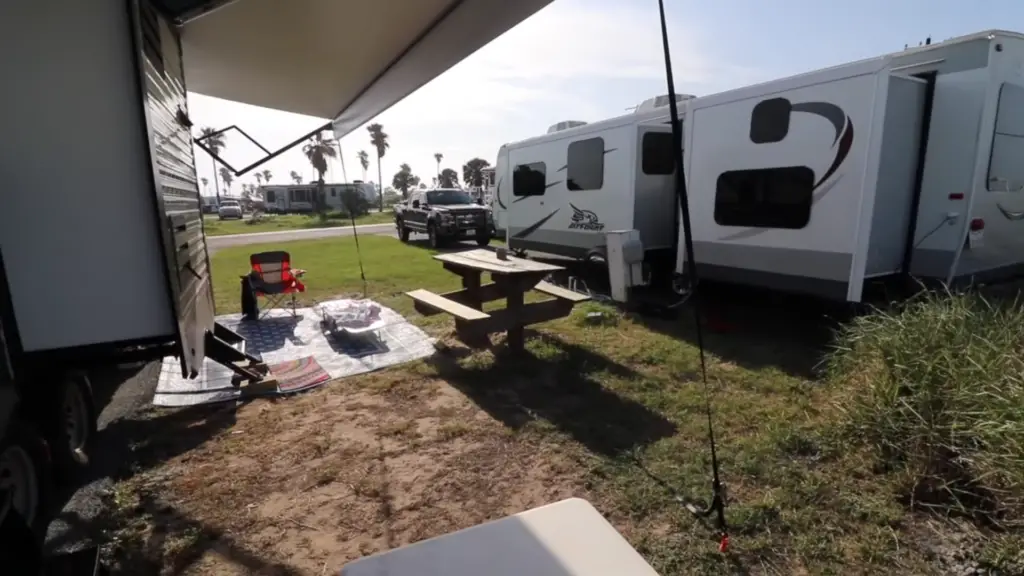
Type of Awning
There are two main types of RV awnings: manual and automatic. Manual awnings are less expensive and easier to install, but they require you to set them up and take them down by hand. Automatic awnings are more expensive, but they’re also much easier to use since they can be operated with the push of a button.
When it comes to wind resistance, automatic awnings are the clear winner. That’s because they’re made with stronger materials and have a sturdier construction. If you’re looking for an awning that can withstand high winds, we recommend going with an automatic model. [1]
Material
RV awnings are typically made from one of two materials: acrylic or vinyl. Acrylic is more expensive but it’s also more durable and UV-resistant.
When it comes to wind resistance, acrylic and vinyl perform about equally well. However, if you live in an area with high winds, we recommend choosing an awning made from acrylic. That’s because it’s more likely to hold up in strong winds without tearing or blowing away. [2]
Condition of the Awning
Even the strongest awnings can be damaged by high winds if they’re not in good condition. That’s why it’s important to inspect your awning regularly and make sure that it doesn’t have any holes or tears. If you do find damage, make sure to get it fixed as soon as possible. Otherwise, you risk the awning being blown away in high winds.
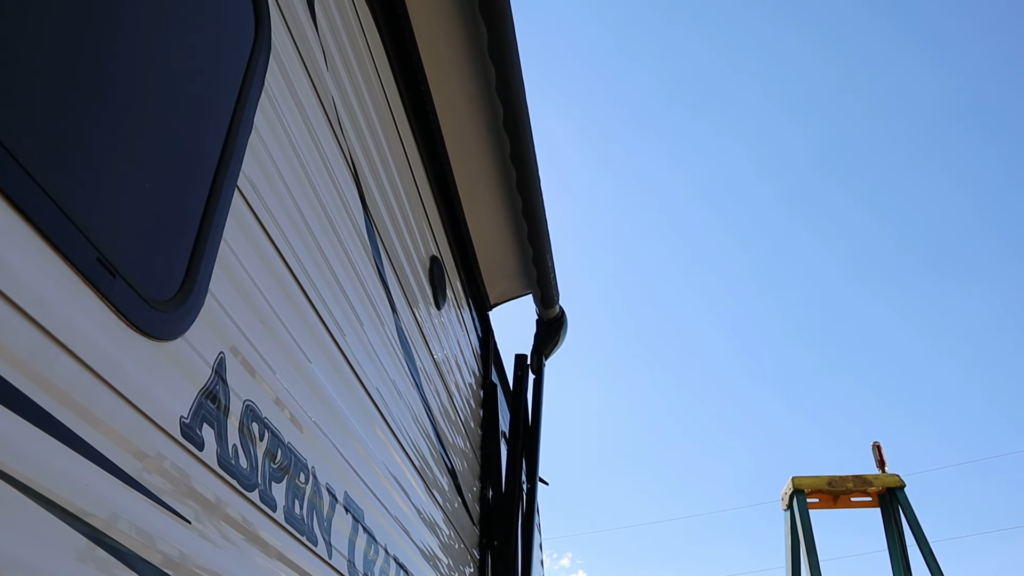
In general, we recommend taking your awning down if there are sustained winds over 25 mph. By regularly cleaning your awning, you will reduce the amount of wear and tear, and it will last longer.
Self-Supported vs. Supported Awnings
There are two main types of RV awnings: self-supported and supported. Self-supported awnings are the most common type and they’re what most people think of when they picture an RV awning. They’re attached to the side of the RV and held up by poles that you insert into the ground.
Supported awnings are less common but they offer some advantages over self-supported models. For one, they’re more stable in high winds since they’re attached to the RV at multiple points. This makes them less likely to blow away or collapse in strong winds. Additionally, supported awnings provide more shade since they can be extended further out from the side of the RV.
If you live in an area with high winds, we recommend choosing a supported awning. They’re more expensive and they require a bit more work to set up, but they offer better protection against strong winds. [3]
How to Roll up Your RV Awning Before High Winds Come Through
If you know that high winds are on the way, the best thing you can do is take down your RV awning. This will help prevent damage to the awning and keep it in good condition.
Taking down an RV awning is fairly simple and only takes a few minutes. First, make sure that all of the straps and buckles are unbuckled so that the awning is loose. Next, begin rolling up the awning from one end. Once it’s rolled up, secure it with the straps or bungee cords that came with your RV.
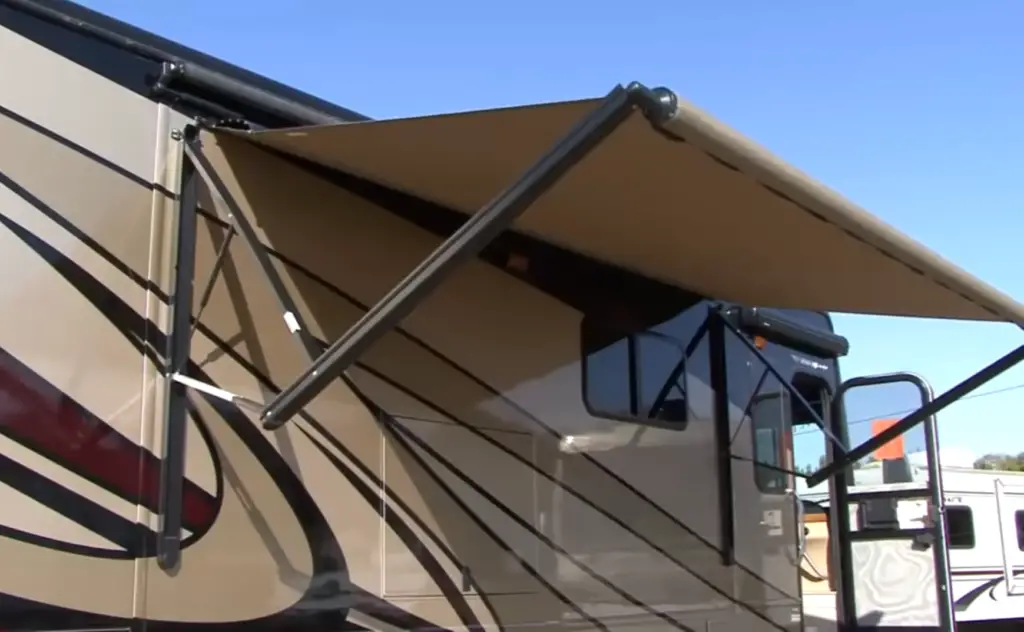
If you don’t have time to take down your awning before high winds hit, there are still some things you can do to help protect it. Ensure that the awning is not restricted by any straps or buckles before continuing. Next, extend the legs on your RV so that they’re fully extended. This will help stabilize the RV and prevent it from tipping over in high winds. Finally, put weight on the awning by placing objects like chairs or coolers on top of it. This will help keep it from blowing away in strong winds.
Rolling up a Standard RV Awning
To ensure that your awning lasts for years to come, you should take the time to roll it up correctly. The process is simple and only takes a few minutes.
First, make sure that the awning is completely dry before rolling it up. If it’s even slightly damp, it could mildew while stored.
Next, raise the awning all the way until it’s fully extended. Once extended, start at one end and begin rolling the awning towards the other.
Once you reach the other end, secure the rolled-up awning with either Velcro straps or bungee cords. These will keep it from unrolling while in storage.
Rolling up a Hybrid RV Awning
To roll up a hybrid RV awning, you’ll need to:
- Start by taking out the wind sensor if your awning has one.
- Then, release the awning’s arms from their locked position by pressing the buttons or levers on each arm.
- Next, fold the arms in toward the center of the awning until they click into place.
- After that, pull the fabric of the awning taut and start rolling it up from one end.
- As you’re rolling it up, make sure to keep an eye on the fabric so that it doesn’t get caught or bunched up.
- Once you’ve rolled up the entire awning, secure it in place with the straps or ties that came with it.
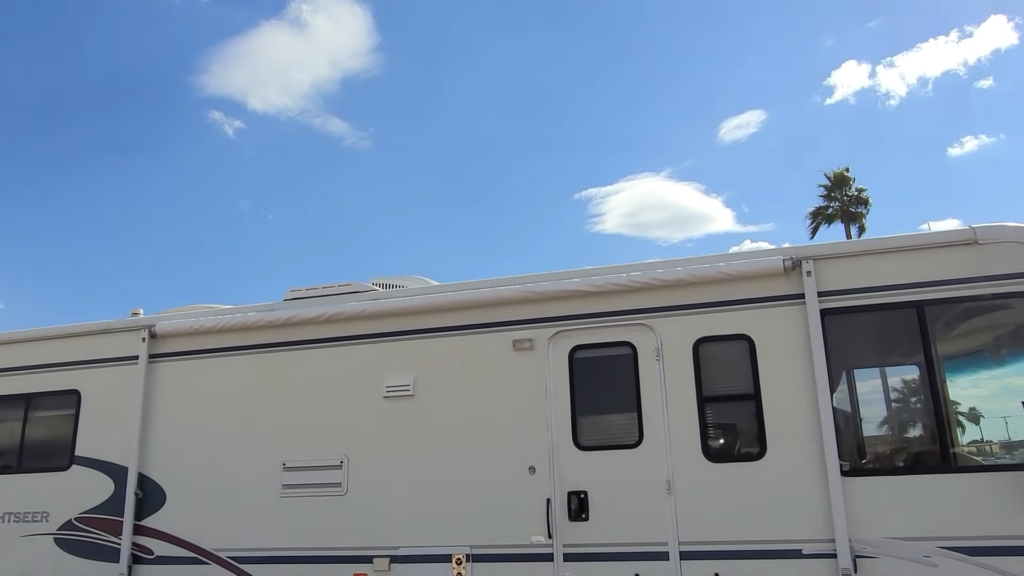
What Can Happen to Your RV Awning in High Winds?
Now that you know how to properly secure your RV awning in high winds, you’re probably wondering what can happen if you don’t. In short, a lot of things can go wrong.
For starters, the fabric of the awning could get ripped or torn if it’s not properly secured. Additionally, the awning itself could become detached from the RV and blow away. And finally, if the arms of the awning are not locked into place, they could collapse, causing serious damage to both the awning and your RV.
So, as you can see, it’s important to take the necessary precautions when securing your RV awning in high winds. By following the tips above, you can help ensure that your awning withstands the wind and remains intact.
Ripped Fabric
The fabric of an RV awning is designed to withstand a certain amount of wind, but if it’s not properly secured, it can easily be ripped or torn.If the fabric of your awning does get ripped or torn, it’s important to repair it as soon as possible. Other causes of damage include: rust, termites and weather. Weather is the most common cause because it can rip off the awning’s metal clips and hinges. Otherwise, further deterioration might occur, resulting in an awning being replaced at some time.
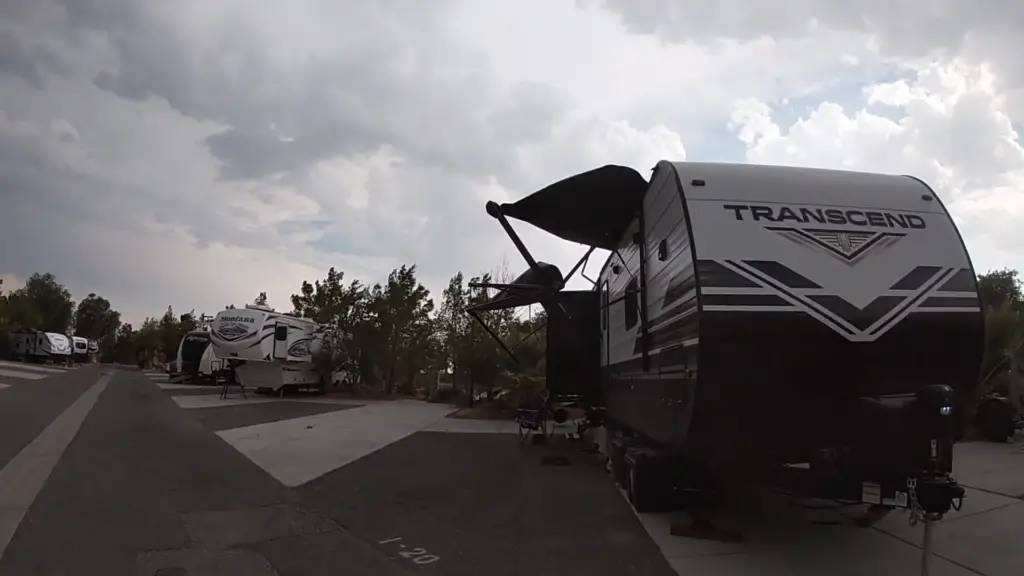
There are a few different ways to repair ripped or torn RV awning fabric. One option is to use special tape that’s designed for repairing outdoor fabrics. Another option is to sew the damaged area together.
If you’re not sure how to repair your awning fabric, it’s best to consult with a professional. They’ll be able to assess the damage and recommend the best course of action.
Bent or Broken Awning
Another problem that can occur when an RV awning is left unsecured in high winds is bent or broken awning arms. The arms of an RV awning are designed to fold in and out, but if they’re not properly secured, they can easily become bent or broken.
Awning Torn Off
It’s not uncommon for an RV awning to be torn off in high winds. In fact, it happens more often than you might think. There are a few things that you can do to prevent this from happening, but first let’s talk about how much wind an RV awning can actually withstand.
The average RV awning is designed to withstand winds up to around 20-25 mph. However, there are some factors that can affect this number. For example, the size and shape of your awning can make it more or less susceptible to high winds. Additionally, the type of material that your awning is made out of will also play a role in its wind resistance.
Smashed RV
Finally, if the awning is not properly secured, it could collapse and cause serious damage to your RV. In some cases, the awning could even smash the windows of your RV.
As you can see, there are a lot of things that can go wrong if you don’t properly secure your RV awning in high winds. That’s why it’s so important to follow the tips above and make sure that your awning is properly secured before the wind picks up.
How to Patch up Weather-Damaged RV Awning
If you’ve ever driven in a strong storm, you know that tree limbs and other debris can cause serious damage to your RV. In many cases, the awning is the first victim. Here are some tips for patching up weather-damaged RV awnings:
- Use duct tape or another heavy-duty adhesive to secure any loose fabric.
- If there are holes or tears, patch them with fabric or vinyl patches.
- If the support structure is damaged, reinforce it with additional supports.
- Make sure all of the hardware is securely fastened.
These tips will help you get your awning back in shape so you can continue enjoying the great outdoors!
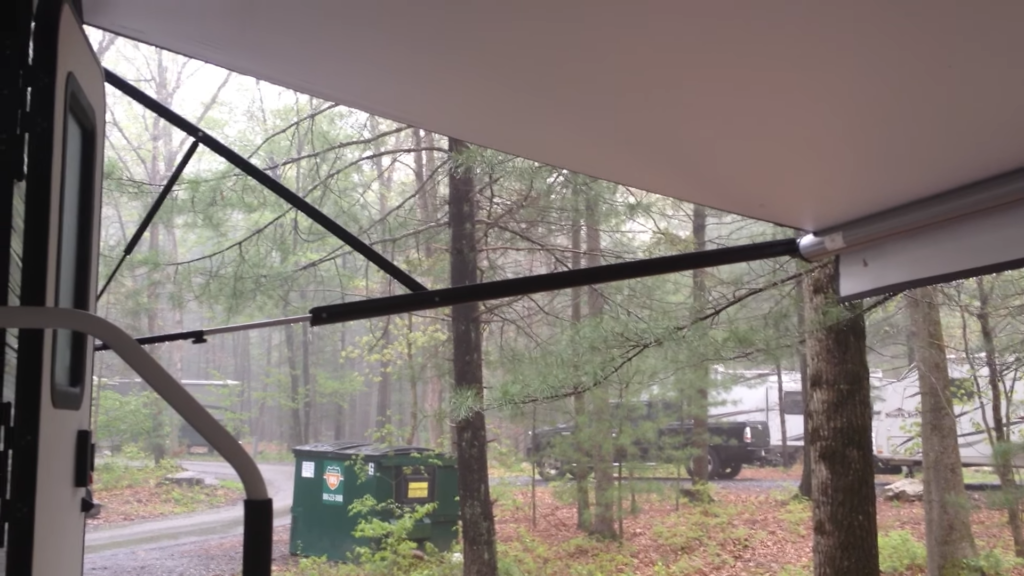
Step 1: Take Down Your Awning
The first step in repairing your awning is to take it down. By having a look at the damage, you’ll be able to better understand the repairs that need to be made.
If you’re not sure how to take down your awning, consult with the manufacturer or a professional. They’ll be able to walk you through the process and make sure that everything is done correctly.
Step 2: Clean the Awning
Once the awning is down, you’ll need to give it a good cleaning. This will remove any dirt, debris, or stains that could make repairs more difficult.
There are a few different ways to clean an RV awning. You can use a hose and some soap, or you can purchase a specialized cleaner from your local RV dealer. Whichever method you choose, be sure to follow the instructions carefully.
Step 3: Repair the Holes
If your awning has any holes or tears, you’ll need to repair them before you can put it back up. There are a few different ways to do this, but the most common method is to use fabric or vinyl patches.
You can purchase patches from your local RV dealer or online. Be sure to get patches that match the material of your awning so they blend in seamlessly.
Once you have your patches, simply cut them to size and attach them to the awning with adhesive.
FAQ
Are awnings OK in the wind?
The size and shape of your awning can make it more or less susceptible to high winds. Additionally, the type of material that it is made out could also affect how much force an object has in regards withmphs/winches when exposed directly towards them
For example: PVC vs Polyester fabrics typically resist water better than others but they both react differently under pressure – this means you’ll want different sizes depending on what kind its being used for!
Use the wind rating provided by the manufacturer to determine how much wind your awning can withstand.
Can you put an RV awning up in the rain?
It’s not recommended to put up your RV awning in the rain because it can cause the fabric to mildew or mold. If you must put up your awning in the rain, be sure to dry it off as soon as possible afterwards. Allowing it to air dry is usually sufficient, but you can also use a hairdryer on the low setting if needed. [6]
Can I leave my RV awning out all season?
Most RV awnings are designed for occasional use and should be taken down when not in use. This helps prevent weather damage and prolongs the life of the awning. If you’re planning to leave your awning up for an extended period of time, consult with the manufacturer first to make sure that it’s designed for that type of use.
How do I know if my RV awning is damaged?
There are a few signs that you can look for to determine if your RV awning is damaged. These include holes, tears, loose fabric, and damage to the support structure. If you notice any of these signs, it’s best to take down the awning and inspect it for further damage.
Of course, the best way to know for sure if your awning is damaged is to consult with the manufacturer or a professional. They’ll be able to give you an accurate assessment of the damage and advise you on the best course of action.
What should I do if my RV awning is damaged?
If your RV awning is damaged, the first step is to take it down. This will give you a better idea of the extent of the damage and it will also make it easier to make repairs. Once the awning is down, you can either repair it yourself or take it to a professional for further assistance.
What wind speed can an awning withstand?
However, there are some factors that can affect this number. For example, the size and shape of your awning can make it more or less susceptible to high winds. Additionally, the type of material that your awning is made out of will also play a role in its wind resistance.If you’re not sure how much wind your awning can withstand, consult with the manufacturer or a professional. They’ll be able to give you an accurate estimate based on the specific model and materials. [7]
How do I protect my RV awning from the wind?
There are a few things that you can do to protect your RV awning from wind damage. First, make sure that it’s properly secured before leaving it unattended. This includes making sure that all of the support arms are locked in place and that the fabric is taut.
You should also consider investing in some type of weather protection for your awning. This could be something as simple as some PVC pipe or hurricane straps. Additionally, you can also purchase special covers that are designed to protect your awning from the elements. [8]
Useful Video: RV Awning High Winds, Cleaning, Maintenance and Your Doing It Wrong / rv awning cleaning
Conclusion
It’s important to know the limits of your RV awning and what it can withstand. Always be cautious when using an RV awning, and never exceed the weight limit. Remember that even if your awning is made with high-quality materials, there is always the potential for damage in windy conditions. Be safe out there!
References
- https://www.mrcoverall.ca/a-manual-or-motorized-awning-which-is-better/
- https://trekers.org/rv-awning/
- https://www.dometic.com/en-ca/outdoor/ca/products/climate/rv-awnings/awning-buying-guide
- https://camperreport.com/repair-torn-camper-awning/
- https://solariscanada.com/blog/how-much-wind-is-too-much-wind-for-a-retractable-awning/
- https://hi-van.com/can-you-use-rv-awnings-in-the-rain/
- https://www.samsonawnings.co.uk/faqs/2016/02/what-wind-speeds-will-an-awning-withstand/
- https://rvlife.com/spring-weather-rv-awning/

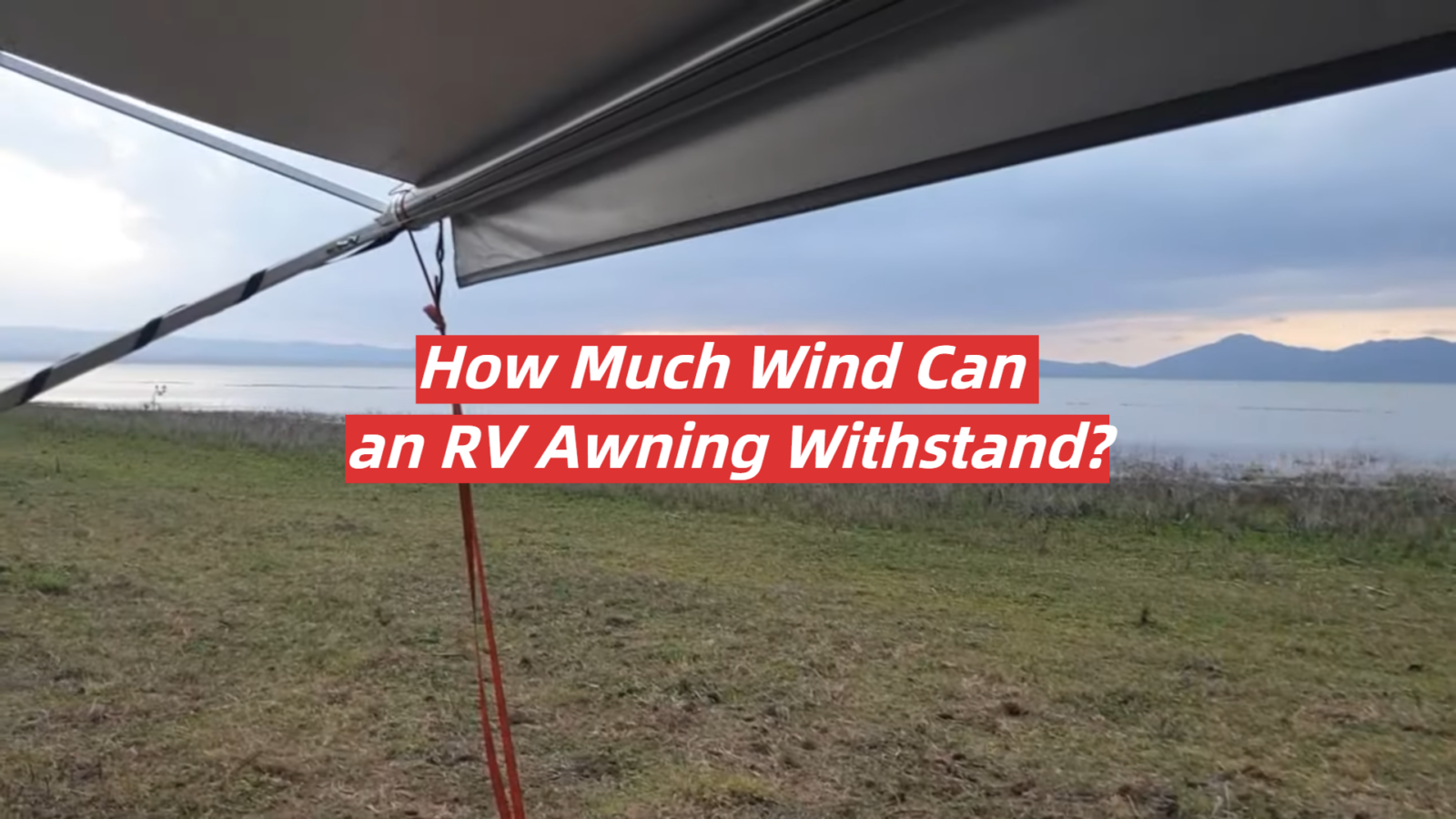

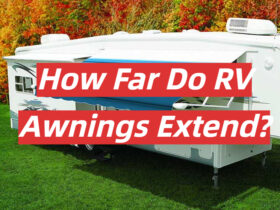

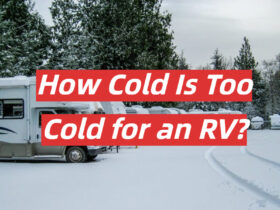
Leave a Reply